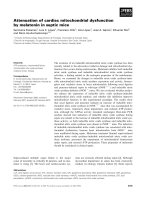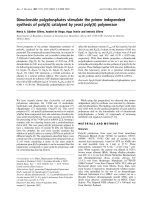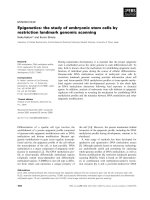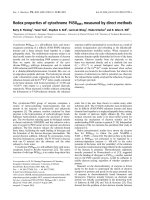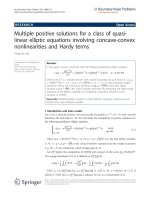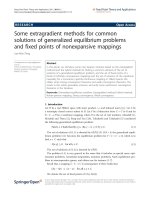MULTIPLE POSITIVE SOLUTIONS OF SINGULAR p-LAPLACIAN PROBLEMS BY VARIATIONAL METHODS KANISHKA PERERA ppt
Bạn đang xem bản rút gọn của tài liệu. Xem và tải ngay bản đầy đủ của tài liệu tại đây (483.02 KB, 6 trang )
MULTIPLE POSITIVE SOLUTIONS OF SINGULAR
p-LAPLACIAN PROBLEMS BY VARIATIONAL METHODS
KANISHKA PERERA AND ZHITAO ZHANG
Received 20 July 2004
We obtain multiple positive solutions of singular p-Laplacian problems using variational
methods. The techniques are applicable to other types of singular problems as well.
1. Introduction
We consider the singular quasilinear elliptic boundary value problem
−∆
p
u = a(x) u
−γ
+ λf(x, u)inΩ,
u>0inΩ,
u = 0on∂Ω,
(1.1)
where Ω is a bounded C
2
domain in R
n
,n ≥ 1, ∆
p
u = div(|∇u|
p−2
∇u)isthep-Laplacian,
1 <p<∞, a ≥ 0 is a nontrivial measurable function, γ>0 is a constant, λ>0isaparam-
eter, and f is a Carath
´
eodory function on Ω × [0,∞) satisfying
sup
(x,t)∈Ω×[0,T]
f (x,t)
< ∞∀T>0. (1.2)
The semilinear case p = 2withγ<1and f = 0 has been studied extensively in both
bounded and unbounded domains (see [5, 6, 7, 10, 11, 12, 14, 20] and their references).
In particular, Lair and Shaker [11] showed the existence of a unique (weak) solution when
Ω is bounded and a
∈ L
2
(Ω). Their result was extended to the sublinear case f (t) = t
β
,
0 <β≤ 1 by Shi and Yao [15] and Wieg ner [18]. In the superlinear case 1 <β<2
∗
− 1
and for small λ, Coclite and Palmieri [4]obtainedasolutionwhena = 1andSunetal.
[16] obtained two solutions using the Ekeland’s variational principle for more general a’s.
Zhang [19] extended their multiplicity result to more general superlinear terms f (t) ≥ 0
using critical point theory on closed convex sets. The ODE case n = 1 was studied by
Agarwal and O’Regan [1] using fixed point theor y and by Agarwal et al. [2] using varia-
tional methods. The purpose of the present paper is to treat the general quasilinear case
p
∈ (1,∞), γ ∈ (0,∞), and f is allowed to change sign. We use a simple cutoff argument
and only the basic critical point theory. Our results seem to be new even for p = 2.
Copyright © 2006 Hindawi Publishing Corporation
Boundary Value Problems 2005:3 (2005) 377–382
DOI: 10.1155/BVP.2005.377
378 Positive solutions of singular p-Laplacian problems
Firstweassume
(H
1
) ∃ϕ ≥ 0inC
1
0
(Ω)andq>nsuch that aϕ
−γ
∈ L
q
(Ω).
This does not require γ<1 as usually assumed in the literature. For example, when Ω is
the unit ball, a(x) = (1 −|x|
2
)
σ
, σ ≥ 0, and γ<σ+1/n,wecantakeϕ(x) = 1 −|x|
2
and
q<1/(γ − σ)(resp.,q with no additional restrictions) if γ>σ(resp., γ ≤ σ).
Theorem 1.1. If (H
1
)and(1.2)holdand f ≥ 0, then ∃λ
0
> 0 such that problem (1.1)has
asolution∀λ ∈ (0,λ
0
).
Corollar y 1.2. Problem (1.1)with f = 0 has a solution if (H
1
) holds.
Next we allow f to change sign, but strengthen (H
1
)to
(H
2
) a ∈ L
∞
(Ω)witha
0
:= inf
Ω
a>0andγ<1/n.
This implies that aϕ
−γ
∈ L
q
(Ω)foranyϕ whose interior normal derivative ∂ϕ/∂ν > 0on
∂Ω and q<1/γ.
Theorem 1.3. If (H
2
)and(1.2)hold,then∃λ
0
> 0 such that problem (1.1)hasasolution
∀λ ∈ (0,λ
0
).
Finally we assume that f is C
1
in t, satisfies
f
t
(x, t)
≤ C
t
r−2
+1
(1.3)
for some 2 ≤ r<p
∗
,andp-superlinear:
0 <θF(x,t) ≤ tf(x,t), t large (1.4)
for some θ>p.Herep
∗
= np/(n − p)(resp.,∞)ifp<n(resp., p ≥ n) is the critical
Sobolev exponent and C denotes a generic positive constant.
Theorem 1.4. If p ≥ 2,(H
1
), (1.3), and (1.4)hold,and f ≥ 0, then ∃λ
0
> 0 such that
problem (1.1)hastwosolutions∀λ ∈ (0,λ
0
).
Theorem 1.5. If p ≥ 2 and (H
2
), (1.3), and (1.4)hold,then∃λ
0
> 0 such that problem
(1.1)hastwosolutions∀λ ∈ (0,λ
0
).
2. Preliminaries on the p-Laplacian
Consider the problem
−∆
p
u = g(x)inΩ,
u = 0on∂Ω.
(2.1)
Proposition 2.1. If g
∈ L
q
(Ω) for some q>n,then(2.1) has a unique weak solution u ∈
C
1
0
(Ω). If, in addition, g ≥ 0 is nontrivial, then
u>0 in Ω, ∂u/∂ν > 0 on ∂Ω. (2.2)
K. Perera and Z. Zhang 379
Proof. The existence of a unique solution u ∈ W
1,p
0
(Ω)iswell-known.Theproblem
−∆v = g(x)inΩ,
v = 0on∂Ω
(2.3)
has a unique solution v
∈ W
2,q
(Ω) C
1,α
(Ω), α = 1 − n/q.Thenu satisfies
div
|∇u|
p−2
∇u − G(x)
=
0inΩ,
u = 0on∂Ω,
(2.4)
where G =∇v ∈ C
α
(Ω), and u is bounded by Guedda and V
´
eron [8] since q>n/pif
p ≤ n,sou ∈ C
1
0
(Ω)byLieberman[13]. The rest now follows from V
´
azquez [17].
3. Proofs of Theorems 1.1 and 1.3
Proof of Theorem 1.1. Since a ∈ L
q
(Ω)by(H
1
), the problem
−∆
p
v = a(x)inΩ,
v = 0on∂Ω
(3.1)
has a unique positive solution v ∈ C
1
0
(Ω)with∂v/∂ν > 0on∂Ω by Proposition 2.1.Then
inf
Ω
(v/ϕ) > 0 and hence av
−γ
∈ L
q
(Ω). Fix 0 <ε≤ 1sosmallthatu := ε
1/(p−1)
v ≤ 1. Then
−∆
p
u − a(x)u
−γ
− λf(x, u) ≤−(1 − ε)a(x) ≤ 0, (3.2)
so u is a subsolution of (1.1).
Since au
−γ
∈ L
q
(Ω), the problem
−∆
p
u = a(x) u(x)
−γ
+1 inΩ,
u = 0on∂Ω
(3.3)
has a unique solution u ∈ C
1
0
(Ω)byProposition 2.1,andu ≥ u since
−∆
p
u ≥ a(x) ≥ εa(x) =−∆
p
u. (3.4)
Then
−∆
p
u − a(x)u
−γ
− λf(x, u) ≥ 1 − λ sup
x∈Ω,t≤max
Ω
u
f (x,t), (3.5)
so ∃λ
0
> 0suchthatu is a supersolution of (1.1) ∀λ ∈ (0,λ
0
)by(1.2).
380 Positive solutions of singular p-Laplacian problems
Let
g
λ,
u
(x, t) =
a(x)u(x)
−γ
+ λf
x, u(x)
, t>u(x)
a(x) t
−γ
+ λf(x, t), u(x) ≤ t ≤ u(x)
a(x) u(x)
−γ
+ λf
x, u(x)
, t<u(x),
G
λ,
u
(x, t) =
t
0
g
λ,
u
(x, s)ds,
Φ
λ,u
(u) =
Ω
|∇u|
p
− pG
λ,u
(x, u), u ∈ W
1,p
0
(Ω).
(3.6)
Since
0 ≤ g
λ,u
(x, t) ≤ a(x)u(x)
−γ
+ λ sup
x∈Ω,t≤max
Ω
u
f (x,t), ∀(x,t) ∈ Ω × R, (3.7)
and au
−γ
∈ L
q
(Ω), Φ
λ,u
is bounded from below and has a global minimizer u
0
, which
then is a solution of (1.1)intheorderinterval[u,u].
Proof of Theorem 1.3. The problem
−∆
p
v = a
0
in Ω,
v = 0on∂Ω
(3.8)
has a unique positive solution v ∈ C
1
0
(Ω)with∂v/∂ν > 0on∂Ω.Fix0<ε<1sosmallthat
u := ε
1/(p−1)
v ≤ 1. Then
−∆
p
u − a(x)u
−γ
− λf(x, u) ≤−(1 − ε)a
0
+ λ sup
x∈Ω,t≤max
Ω
u
f (x,t)
, (3.9)
so
∃λ
0
> 0suchthatu is a subsolution of (1.1 ) ∀λ ∈ (0,λ
0
). The rest of the proof now
proceeds as above.
4. Proofs of Theorems 1.4 and 1.5
Proof of Theorem 1.4. Define a Carath
´
eodory function on Ω × R by
g
λ
(x, t) =
a(x) t
−γ
+ λf(x, t), t ≥ u(x)
a(x) u(x)
−γ
+ λf
x, u(x)
, t<u(x)
(4.1)
and consider the problem
−∆
p
u = g
λ
(x, u)inΩ,
u = 0on∂Ω.
(4.2)
Every solution of (4.2)is≥ u and hence also a solution of (1.1). By (1.3),
0 ≤ g
λ
(x, t) ≤ a(x)u(x)
−γ
+ λC
t
+
r−1
+1
, ∀(x,t) ∈ Ω × R (4.3)
K. Perera and Z. Zhang 381
so solutions of (4.2) are the critical points of the C
1
functional
Φ
λ
(u) =
Ω
|∇u|
p
− pG
λ
(x, u), u ∈ W
1,p
0
(Ω), (4.4)
where G
λ
(x, t) =
t
0
g
λ
(x, s)ds.
Since u
0
solves
−∆
p
u = g
λ,u
x, u
0
(x)
in Ω,
u = 0on∂Ω
(4.5)
and g
λ,u
(·,u
0
(·)) ∈ L
q
(Ω)by(3.7), u
0
∈ C
1
0
(Ω)byProposition 2.1. Note that, with a pos-
sibly smaller λ
0
,2u is also a supersolution of (1.1) ∀λ ∈ (0,λ
0
). We assume that u
0
is the
global minimizer of the corresponding functional Φ
λ,2u
also, for otherwise we are done.
Since
u
0
≤ u<2u in Ω, ∂u
0
/∂ν ≤ ∂u/∂ν <∂(2u)/∂ν on ∂Ω, (4.6)
Φ
λ,2u
= Φ
λ
in a C
1
0
(Ω)-neighborhood of u
0
,sou
0
is a local minimizer of Φ
λ
|
C
1
0
(Ω)
,and
hence also of Φ
λ
by Brezis and Nirenberg [3]forp = 2 and by Guo and Zhang [9]for
p>2. The mountain pass lemma now gives a second critical point as (1.4) implies that
Φ
λ
satisfies the (PS) condition and Φ
λ
(tu) →−∞as t →∞.
Proof of Theorem 1.5 is similar and therefore omitted.
Acknowledgments
We would like to thank Professor Marco Degiovanni for showing us the proof of
Proposition 2.1 and Professor Mabel Cuesta and Professor Jean-Pierre Gossez for their
helpful comments about the p-Laplacian. The first author was supported in part by
the National Science Foundation. The second author was suppor ted in part by the Na-
tional Natural Science Foundation of China, Ky and Yu-Fen Fan Endowment of the AMS,
Florida Institute of Technology, and the Humboldt Foundation.
References
[1] R.P.AgarwalandD.O’Regan,Singular boundary value problems for supe rlinear second order
ordinary and delay differential equations,J.Differential Equations 130 (1996), no. 2, 333–
355.
[2] R. P. Agarwal, K. Perera, and D. O’Regan, Multiple positive solutions of singular problems by
variational methods, to appear in Proc. Amer. Math. Soc.
[3] H. Brezis and L. Nirenberg, H
1
versus C
1
local minimizers,C.R.Acad.Sci.ParisS
´
er. I Math.
317 (1993), no. 5, 465–472.
[4] M.M.CocliteandG.Palmieri,On a singular nonlinear Dir ichlet problem, Comm. Partial Dif-
ferential Equations 14 (1989), no. 10, 1315–1327.
[5] M. G. Crandall, P. H. Rabinowitz, and L. Tartar, On a Dirichlet problem with a singular nonlin-
earit y,Comm.PartialDifferential Equations 2 (1977), no. 2, 193–222.
[6] J. I. Diaz, J M. Morel, and L. Oswald, An elliptic equation with singular nonlinearity, Comm.
Partial Differential Equations 12 (1987), no. 12, 1333–1344.
382 Positive solutions of singular p-Laplacian problems
[7] A.L.Edelson,Entire solutions of singular elliptic equations, J. Math. Anal. Appl. 139 (1989),
no. 2, 523–532.
[8] M. Guedda and L. V
´
eron, Quasilinear elliptic equations involving critical Sobolev exponents,
Nonlinear Anal. 13 (1989), no. 8, 879–902.
[9] Z. Guo and Z. Zhang, W
1,p
versus C
1
local minimizers and multiplicity results for quasilinear
elliptic equations,J.Math.Anal.Appl.286 (2003), no. 1, 32–50.
[10] T. Kusano and C. A. Swanson, Entire positive solutions of singular semilinear elliptic equations,
Japan. J. Math. (N.S.) 11 (1985), no. 1, 145–155.
[11] A. V. Lair and A. W. Shaker, Classical and weak solutions of a singular semilinear elliptic problem,
J. Math. Anal. Appl. 211 (1997), no. 2, 371–385.
[12] A. C. Lazer and P. J. McKenna, On a singular nonlinear elliptic boundary-value problem,Proc.
Amer. Math. Soc. 111 (1991), no. 3, 721–730.
[13] G. M. Lieberman, Boundary regularity for solutions of degene rate elliptic equations, Nonlinear
Anal. 12 (1988), no. 11, 1203–1219.
[14] A. W. Shaker, On singular semilinear elliptic equations, J. Math. Anal. Appl. 173 (1993), no. 1,
222–228.
[15] J. Shi and M. Yao, On a singular nonlinear semilinear elliptic problem, Proc. Roy. Soc. Edinburgh
Sect. A 128 (1998), no. 6, 1389–1401.
[16] Y. Sun, S. Wu, and Y. Long, Combined effects of singular and supe rlinear nonlinearities in some
singular boundary value problems,J.Differential Equations 176 (2001), no. 2, 511–531.
[17] J. L. V
´
azquez, A strong maximum principle for some quasilinear elliptic equations,Appl.Math.
Optim. 12 (1984), no. 3, 191–202.
[18] M. Wiegner, A degenerate diffusion equation with a nonlinear source te rm, Nonlinear Anal. 28
(1997), no. 12, 1977–1995.
[19] Z. Zhang, Critical points and posit ive solutions of singular elliptic boundary value problems,J.
Math. Anal. Appl. 302 (2005), no. 2, 476–483.
[20] M. A. del Pino, A global estimate for the gradient in a singular elliptic boundary value problem,
Proc. Roy. Soc. Edinburgh Sect. A 122 (1992), no. 3-4, 341–352.
Kanishka Perera: Department of Mathematical Sciences, Florida Institute of Technology,
Melbourne, FL 32901, USA
E-mail address: kperera@fit.edu
Zhitao Zhang: Academy of Mathematics and Systems Science, Institute of Mathematics, Chinese
Academy of Sciences, Beijing 100080, China
E-mail address:
